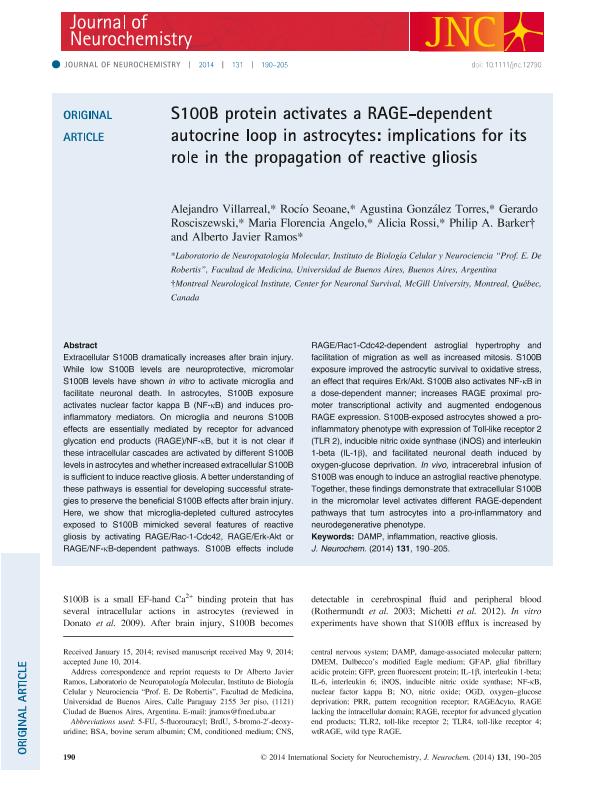Artículo
S100B protein activates a RAGE-dependent autocrine loop in astrocytes: implications for its role in the propagation of reactive gliosis
Villarreal, Alejandro ; Seoane, Rocío; Gónzalez Torres, Agustina; Rosciszewski, Gerardo Ariel
; Seoane, Rocío; Gónzalez Torres, Agustina; Rosciszewski, Gerardo Ariel ; Angelo, María Florencia
; Angelo, María Florencia ; Rossi, Alicia; Barker, Philip A.; Ramos, Alberto Javier
; Rossi, Alicia; Barker, Philip A.; Ramos, Alberto Javier
 ; Seoane, Rocío; Gónzalez Torres, Agustina; Rosciszewski, Gerardo Ariel
; Seoane, Rocío; Gónzalez Torres, Agustina; Rosciszewski, Gerardo Ariel ; Angelo, María Florencia
; Angelo, María Florencia ; Rossi, Alicia; Barker, Philip A.; Ramos, Alberto Javier
; Rossi, Alicia; Barker, Philip A.; Ramos, Alberto Javier
Fecha de publicación:
06/2014
Editorial:
Wiley
Revista:
Journal of Neurochemistry
ISSN:
0022-3042
e-ISSN:
1471-4159
Idioma:
Inglés
Tipo de recurso:
Artículo publicado
Clasificación temática:
Resumen
Extracellular S100B dramatically increases after brain injury. While low S100B levels are neuroprotective, micromolar S100B levels have shown in vitro to activate microglia and facilitate neuronal death. In astrocytes, S100B exposure activates nuclear factor kappa B (NF-κB) and induces pro-inflammatory mediators. On microglia and neurons S100B effects are essentially mediated by receptor for advanced glycation end products (RAGE)/NF-κB, but it is not clear if these intracellular cascades are activated by different S100B levels in astrocytes and whether increased extracellular S100B is sufficient to induce reactive gliosis. A better understanding of these pathways is essential for developing successful strategies to preserve the beneficial S100B effects after brain injury. Here, we show that microglia-depleted cultured astrocytes exposed to S100B mimicked several features of reactive gliosis by activating RAGE/Rac-1-Cdc42, RAGE/Erk-Akt or RAGE/NF-κB-dependent pathways. S100B effects include RAGE/Rac1-Cdc42-dependent astroglial hypertrophy and facilitation of migration as well as increased mitosis. S100B exposure improved the astrocytic survival to oxidative stress, an effect that requires Erk/Akt. S100B also activates NF-κB in a dose-dependent manner; increases RAGE proximal promoter transcriptional activity and augmented endogenous RAGE expression. S100B-exposed astrocytes showed a pro-inflammatory phenotype with expression of Toll-like receptor 2 (TLR 2), inducible nitric oxide synthase (iNOS) and interleukin 1-beta (IL-1β), and facilitated neuronal death induced by oxygen-glucose deprivation. In vivo, intracerebral infusion of S100B was enough to induce an astroglial reactive phenotype. Together, these findings demonstrate that extracellular S100B in the micromolar level activates different RAGE-dependent pathways that turn astrocytes into a pro-inflammatory and neurodegenerative phenotype.
Palabras clave:
Damp
,
Inflammation
,
Reactive Gliosis
Archivos asociados
Licencia
Identificadores
Colecciones
Articulos(IBCN)
Articulos de INST.DE BIOLO.CEL.Y NEURCS."PROF.E.DE ROBERTIS"
Articulos de INST.DE BIOLO.CEL.Y NEURCS."PROF.E.DE ROBERTIS"
Citación
Villarreal, Alejandro; Seoane, Rocío; Gónzalez Torres, Agustina; Rosciszewski, Gerardo Ariel; Angelo, María Florencia; et al.; S100B protein activates a RAGE-dependent autocrine loop in astrocytes: implications for its role in the propagation of reactive gliosis; Wiley; Journal of Neurochemistry; 131; 2; 6-2014; 190-205
Compartir
Altmétricas



